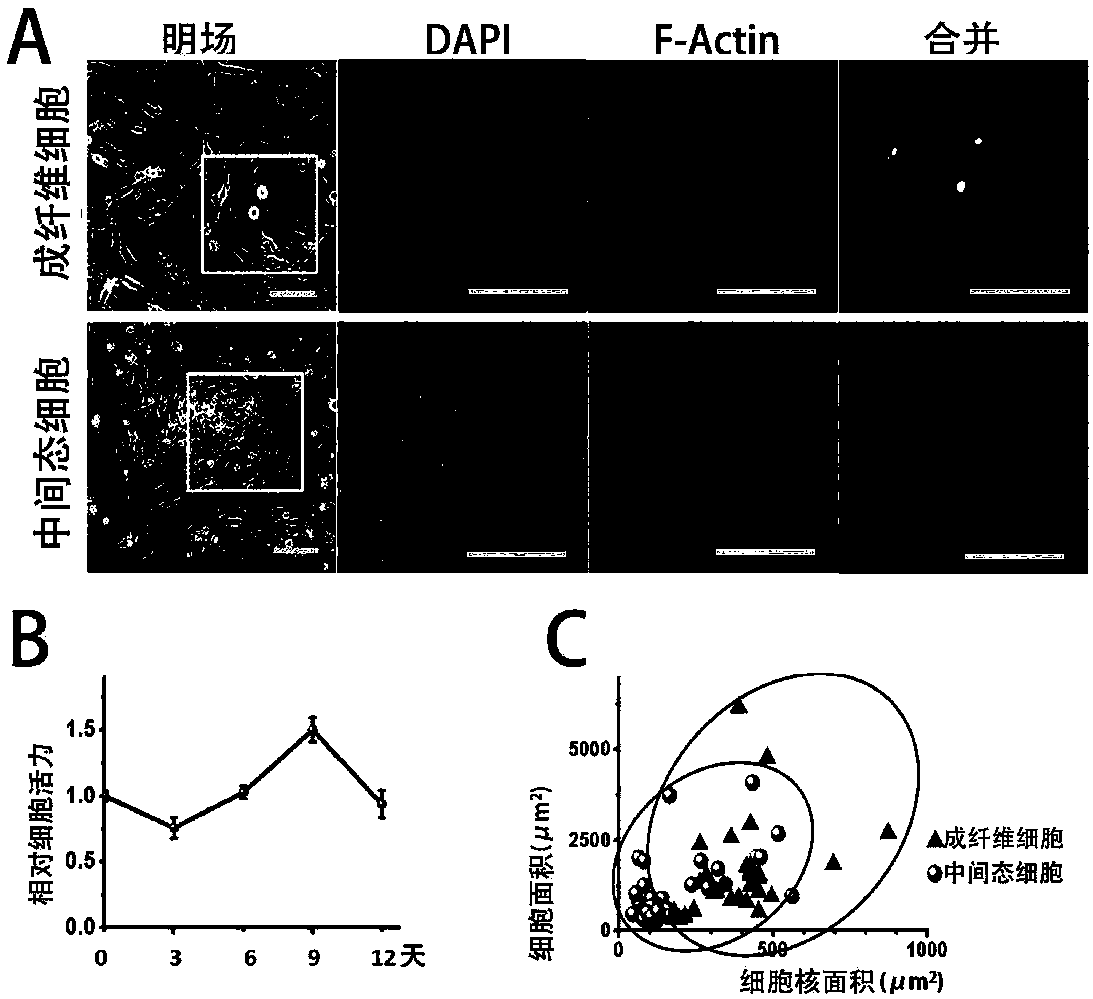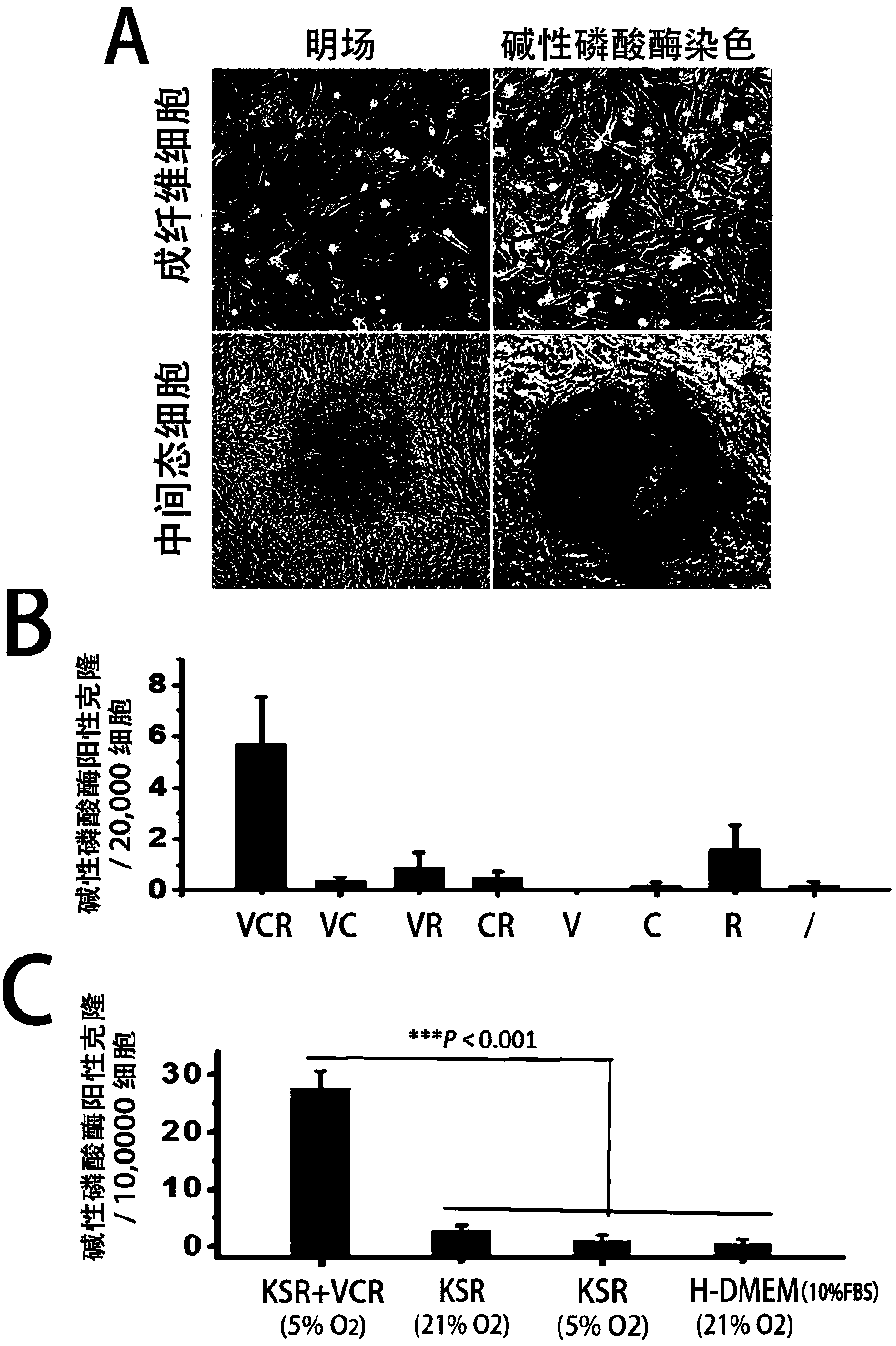Method for inducing mouse fibroblasts into cartilage by adopting small-molecule composition
A technology of fibroblasts, composition, applied in the field of biotechnology and cartilage repair
- Summary
- Abstract
- Description
- Claims
- Application Information
AI Technical Summary
Problems solved by technology
Method used
Image
Examples
Embodiment 1
[0053] Example 1: Induction of mouse embryonic fibroblasts into intermediate cells and characterization
[0054] 1. Experiment
[0055] 1.1 Primary extraction and culture of mouse embryonic fibroblasts
[0056] Get 13.5-day-old C57BL / 6J mouse embryos, cut off the head, limbs, internal organs, gonads and spine, mince the remaining tissues, and digest with 0.05% trypsin (Gibico) for 5 minutes. Add high glucose DMEM medium (i.e. H-DMEM medium containing 10% FBS) containing volume concentration 10% fetal bovine serum (FBS, Gibico) to stop digestion, centrifuge at 1200-1500rpm for 3-5 minutes, and precipitate with 10% Resuspend in H-DMEM medium with FBS, put into culture dish, culture at 37°C, replace with fresh H-DMEM medium containing 10% FBS after adherence. Cultivate at 37°C until the cells cover 80-90% of the culture dish, then cryopreserve or subculture, and obtain 1-3 generations of wild-type mouse embryonic fibroblasts.
[0057] 1.2 Chemical induction of intermediate cel...
Embodiment 2
[0083] Example 2: Chondrogenic induction of intermediate cells
[0084] 1. Experiment
[0085] 1.1 Chondrogenic induction of intermediate cells
[0086] The 2nd generation wild-type mouse embryonic fibroblasts prepared in Example 1 were mixed with 1×10 5 The density of cells / well was planted in a 12-well plate supplemented with H-DMEM medium containing 10% FBS, cultivated at 37°C until the cells grew to 90% density, the medium was removed, and the small molecule composition (V0. 5mM+C3μM+R1μM) chemical induction medium, cultivated in 37°C, 5% oxygen, 5% carbon dioxide (the rest is nitrogen) environment for 6-9 days, and replace fresh chemical containing small molecule composition every 2-3 days induction medium. Discard supernatant culture medium, add chondrogenic induction medium, at 37 ℃, 21% oxygen, 5% carbon dioxide (the rest is nitrogen) environment and cultivate 14 days, every 3-4 days change fresh chondrogenic induction medium.
[0087] The final concentration of th...
Embodiment 3
[0108] Example 3: Combined screening to obtain an optimized composition of small molecule compositions
[0109] 1.1 Safranin O staining confirmed the basic induction model.
[0110] The second-generation wild-type mouse embryonic fibroblasts prepared in step 1.1 of Example 1 were planted at a density of 3000 / well in a 96-well plate supplemented with H-DMEM medium containing 10% FBS, and cultured at 37°C until Cells grew to 90% density, the culture medium was removed, slowly added chemical induction medium containing small molecule composition (VPA 0.5mM, CHIR-98014 3μM and Repsox 1μM), 37°C, 5% oxygen, 5% carbon dioxide (other Cultivate in a nitrogen) environment, replace the fresh chemical induction medium containing the small molecule composition VCR every 2-3 days, and after cultivating for 6 days, replace the chemical induction medium as the cartilage induction medium (the composition is the same as that of Example 2 step 1.1) , at 37° C., in an environment of 21% oxygen ...
PUM
 Login to View More
Login to View More Abstract
Description
Claims
Application Information
 Login to View More
Login to View More - R&D
- Intellectual Property
- Life Sciences
- Materials
- Tech Scout
- Unparalleled Data Quality
- Higher Quality Content
- 60% Fewer Hallucinations
Browse by: Latest US Patents, China's latest patents, Technical Efficacy Thesaurus, Application Domain, Technology Topic, Popular Technical Reports.
© 2025 PatSnap. All rights reserved.Legal|Privacy policy|Modern Slavery Act Transparency Statement|Sitemap|About US| Contact US: help@patsnap.com



